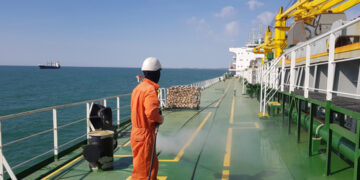Oxygen-depleting cargoes and materials onboard ships refer to substances that can consume or displace oxygen within confined spaces like cargo holds, leading to hazardous conditions for crew members.
A prominent risk with such cargoes is oxygen depletion due to the inherent form of the cargo, for example, self-heating, oxidation of metals and ores or decomposition of vegetable oils, fish oils, animal fats, grain and other organic materials or their residues.
Seafarers remain at the highest risk of losing their lives in enclosed spaces on board ships. Notably, a surge in enclosed space-related fatalities in late 2023 prompted InterManager to urge the shipping industry to collaborate on improving safety in these hazardous areas. In response, the Association recently submitted a paper to the IMO, sharing lessons learned and highlighting the alarming trend of deaths in enclosed spaces on board ships.
The materials listed below are known to be capable of causing oxygen depletion. However, the list is not exhaustive. Oxygen depletion may also be caused by other materials of vegetable or animal origin, by flammable or spontaneously combustible materials and by materials with a high metal content, including, but not limited to:
- grain, grain products and residues from grain processing (such as bran, crushed grain, crushed malt or meal), hops, malt husks and spent malt;
- oilseeds as well as products and residues from oilseeds (such as seed expellers, seed cake, oil cake and meal);
- copra;
- wood in such forms as packaged timber, round wood, logs, pulpwood, props (pit props and other propwood), woodchips, woodshavings, wood pellets and sawdust;
- jute, hemp, flax, sisal, kapok, cotton and other vegetable fibers (such as esparto grass/Spanish grass, hay, straw, bhusa), empty bags, cotton waste, animal fibers, animal and vegetable fabric, wool waste and rags;
- fish, fishmeal and fish scrap;
- guano;
- sulphidic ores and ore concentrates;
- charcoal, coal, lignite and coal products;
- direct reduced iron (DRI);
- dry ice;
- metal wastes and chips, iron swarf, steel and other turnings, borings, drillings, shavings, filings and cuttings; and
- scrap metal.
To mitigate risks, enclosed spaces and cargo holds must be ventilated, and oxygen levels should be monitored regularly using oxygen meters before entry. Proper ventilation and protective equipment are crucial to prevent asphyxiation hazards in such environments.
Other hazards related to specific types of ships, cargo or operations
#1 Dangerous goods in packaged form: The atmosphere of any space containing dangerous goods may put at risk the health or life of any person entering it. Dangers may include flammable, toxic or corrosive gases or vapors that displace oxygen, residues on packages and spilled material. The same hazards may be present in spaces adjacent to the cargo spaces.
Personnel required to deal with spillages or to remove defective or damaged packages should be appropriately trained and wear suitable breathing apparatus and appropriate protective clothing.
#2 Liquid Bulk: The tanker industry has produced extensive advice to operators and crews of ships engaged in the bulk carriage of oil, chemicals and liquefied gases, in the form of specialist international safety guides. Information in the guides on enclosed space entry amplifies these recommendations and should be used as the basis for preparing entry plans.
Crew should be alerted to the danger which will arise if liquid cargo leaks from defective pumps or cargo piping systems into the pump-room bilges.
#3 Solid Bulk: On ships carrying solid bulk cargoes, dangerous atmospheres may develop in cargo spaces and adjacent spaces. The dangers may include flammability, toxicity, oxygen depletion or self-heating, as identified in the shipper’s declaration. For additional information, reference should be made to the International Maritime Solid Bulk Cargoes (IMSBC) Code
#4 Use of Nitrogen as an inert gas: Nitrogen is a colorless and odorless gas that, when used as an inert gas, causes oxygen deficiency in enclosed spaces and at exhaust openings on deck during purging of tanks
and void spaces and use in cargo holds.
It should be noted that one deep breath of 100% nitrogen gas will be fatal. Refer to guidelines on tank entry on
tankers using nitrogen as an inerting medium.
#5 Fumigation: Spaces adjacent to fumigated spaces should be treated as if fumigated. Care should be taken to ensure that piping leading from cargo spaces or adjacent connected spaces through the ship’s accommodation are properly sealed in accordance with Class requirements.
Fumigated Cargo Transport Units (CTUs) may contain dangerous levels of highly toxic chemicals and pose hazards to crew. Such hazards to personnel arising from the operations involved in the carriage of fumigated CTUs are to be addressed.

































































